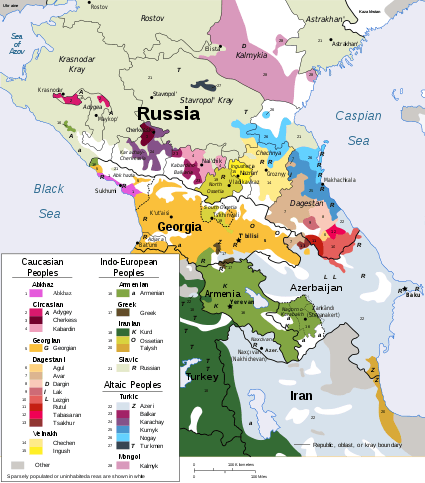Caucasian Federation
The Caucasian Federation was an early 20th century project about the creation of a Pan-Caucasian federation or confederation.

Caucasian Home
There were two strands to the concept: nationalistic and extreme liberal. Gamsakhurdia was one of the most important advocates of the nationalistic idea of a Common Caucasian Home, which in his opinion should unite the 'indigenous' Caucasian peoples such as the North Caucasian 'highlanders' and Georgians in solidarity against Russia. Former Georgian Prime Minister Zurab Zhvania advocated another strand of the Common Caucasian Home idea, which included all peoples of the region and called for petty ethnic divisions in the Caucasus to be transcended. However, divisions between the differing ethnic groups and a lack of commonalities meant that there was little desire to unite as a regional group and little progress was made.[1]
History

A cooperative initiative with a far longer history in the Caucasus is the concept of the "All Caucasian Home" this idea first appeared in 1918 and advocated the creation of a union of all states and governments of the region under a federal aegis guaranteeing each member's autonomy. Between 1920 and 1924 years Chechnya, Ingushetia, North Ossetia, Kabardia, Balkaria, and Karachay did form such an alliance, called the Mountain Republic. In 1919, Georgia and Azerbaijan signed a defense pact against Russia, these moves were undermined by Armenia which rejected the idea of a confederation and claimed that orientation toward the Caucasus was not in its interest.[2] Nevertheless, efforts and dialogue toward the goal of southern Caucasian federation continued under enthusiastic pressure from the west. As a result, in May 1921 in Paris, representative of Azerbaijan, Armenia, Georgia, and the Mountain Republics formed The Union of Independent Caucasian Republics, which served the basis for the ratification of Declaration of the Federal Caucasian Republic two months later. However, this document was not legally binding, as the Soviets had already taken control of the Caucasus by then, in March 1922 the communists instated the Trans-Caucasian Federation of three republics that naturally became part of the Soviet Union. This idea of a Caucasian confederacy was strictly ideological and economic in character and therefore did not take hold. In 1936 this confederacy disbanded and Azerbaijan, Armenia, and Georgia became directly under the control of the Soviet Union.
The idea of "Caucasian Home" became popular immediately after the fall of Soviet Union, especially in the Northern Caucasus. the most active proponent of this idea was Chechnya-Ichkeria led by Dzokhar Dudayev. The Caucasian Mountain National Confederacy was created on this basis of this idea. However, this organization did not find favor in the south, especially because of the north's support of Abkhazia in the war Georgia, and because CMNC was de facto a Muslim organization.

Nevertheless, interest reemerged in February 1996 after Georgian president Shevardnadze proposed the creation of "Peaceful Caucasus". The concrete result followed when in 8 march 1996, in the course of an official visit to Georgia by Azeri president, a joint Declaration on Peace, Stability, and Security in the Caucasian Region was signed. This document was regarded by many as a breakthrough and a serious step toward the realization of "All-Caucasian Home". Among the document's salient points was a call for combined efforts to provide safe transportation of goods and people. One potentially important consequence of the 1996 declaration was the decision to initiate cooperation between the Georgian and Azeri parliaments. this could be a first step in encouraging the Armenian parliament and other Caucasian governments to participate and create a "Caucasian Parliament," composed of deputies from the parliaments of participating countries as well as delegates chosen through direct elections.
Two countries alone cannot guarantee the security of the southern Caucasus, however. Only a union of three would make such a guarantee possible, and thus, without Armenia's participation, one cannot speak of full regional cooperation. As long as the Nagorno-Karabakh conflict remains unresolved, Armenia's relations with Azerbaijan will continue to stagnate and effectively block practical cooperation between the republics. To a lesser, but nonetheless signification degree, Armeno-Georgian relations have been complicated by Armenia's support of Abkhazia as well as the southern Georgian region of Javakheti and it's ethnic Armenian majority. At the same time, Armenia is conscious of the economic cost of continued isolation from its neighbors. The continued development of oil and transport routes raises concern that it will be left out of future economic development in the region. A regional agreement could be reached if Armenia gave up its territorial claims in exchange for access to oil resources. One analyst suggested the creation of a regional consortium of southern Caucasian states for the export of energy. Such a consortium would be overseen pipeline routes and the transportation of oil and gas, by which each country would receive its constant share irrespective of the means and route of transportation. such economic cooperation, in which three states benefit mutually, could promote the compromises necessary for the resolution of political disagreements, including ethnic and territorial disputes.
See also
- Transcaucasian Democratic Federative Republic
- Transcaucasian Socialist Federative Soviet Republic
- Mountainous Republic of the Northern Caucasus
Further reading
Renata Dwan. Building security in Europe's new borderlands. Armonk, N.Y. M.E. Sharpe, 1999